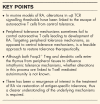The thymus and rheumatology: should we care?
- PMID: 26751840
- PMCID: PMC4732010
- DOI: 10.1097/BOR.0000000000000251
The thymus and rheumatology: should we care?
Abstract
Purpose of review: The purpose of this review is to discuss the mechanisms of central and peripheral tolerance in relation to T-cell mediated autoimmunity in rheumatoid arthritis (RA).
Recent findings: The well established association between major histocompatibility complex class II and RA has led us to understand that T cells, and the adaptive immune response, are important in the pathogenesis of disease. In order for autoimmune disease to develop, there is a breach of tolerance to self antigen and the mechanisms of both central and peripheral tolerance aim to prevent this. Here, we review evidence from mouse models indicating that alterations in T-cell receptor signalling thresholds during thymic selection may be linked to the escape of T cells that mediate autoimmune arthritis. In addition, we summarize the role of dendritic cells and Foxp3+ regulatory T cells in both peripheral and thymic tolerance, and highlight their relevance to what we know about the aetiology of RA.
Summary: Mechanisms of central tolerance in the thymus and peripheral tolerance are in place to control autoreactive T cells and to prevent the development of autoimmune disease. We anticipate that a better understanding of these mechanisms will lead to the development of better, antigen-specific therapeutics to restore tolerance.
Figures


Similar articles
-
Medullary thymic epithelial cells and CD8α+ dendritic cells coordinately regulate central tolerance but CD8α+ cells are dispensable for thymic regulatory T cell production.J Autoimmun. 2016 Dec;75:141-149. doi: 10.1016/j.jaut.2016.08.002. Epub 2016 Aug 16. J Autoimmun. 2016. PMID: 27543048 Free PMC article.
-
Thymic commitment of regulatory T cells is a pathway of TCR-dependent selection that isolates repertoires undergoing positive or negative selection.Curr Top Microbiol Immunol. 2005;293:43-71. doi: 10.1007/3-540-27702-1_3. Curr Top Microbiol Immunol. 2005. PMID: 15981475 Review.
-
Tolerogenic dendritic cells and rheumatoid arthritis: current status and perspectives.Rheumatol Int. 2012 Apr;32(4):837-44. doi: 10.1007/s00296-011-2133-2. Epub 2011 Sep 9. Rheumatol Int. 2012. PMID: 21904923 Review.
-
Dendritic cell-regulatory T-cell interactions control self-directed immunity.Immunol Cell Biol. 2007 Nov-Dec;85(8):575-81. doi: 10.1038/sj.icb.7100088. Epub 2007 Jun 26. Immunol Cell Biol. 2007. PMID: 17592494 Review.
-
Collective Genetic Interaction Effects and the Role of Antigen-Presenting Cells in Autoimmune Diseases.PLoS One. 2017 Jan 12;12(1):e0169918. doi: 10.1371/journal.pone.0169918. eCollection 2017. PLoS One. 2017. PMID: 28081217 Free PMC article.
Cited by
-
The role of the thymus in COVID-19 disease severity: implications for antibody treatment and immunization.Hum Vaccin Immunother. 2021 Mar 4;17(3):638-643. doi: 10.1080/21645515.2020.1818519. Epub 2020 Oct 16. Hum Vaccin Immunother. 2021. PMID: 33064620 Free PMC article. Review.
-
The RANKL-RANK Axis: A Bone to Thymus Round Trip.Front Immunol. 2019 Mar 29;10:629. doi: 10.3389/fimmu.2019.00629. eCollection 2019. Front Immunol. 2019. PMID: 30984193 Free PMC article. Review.
-
The function of myeloid dendritic cells in rheumatoid arthritis.Rheumatol Int. 2017 Jul;37(7):1043-1051. doi: 10.1007/s00296-017-3671-z. Epub 2017 Feb 24. Rheumatol Int. 2017. PMID: 28236220 Review.
-
Association between AIRE gene polymorphism and rheumatoid arthritis: a systematic review and meta-analysis of case-control studies.Sci Rep. 2017 Oct 26;7(1):14096. doi: 10.1038/s41598-017-14375-z. Sci Rep. 2017. PMID: 29074995 Free PMC article.
-
The rs878081 polymorphism of AIRE gene increases the risk of rheumatoid arthritis in a Chinese Han population: a case-control study.Braz J Med Biol Res. 2018 Nov 1;51(12):e7944. doi: 10.1590/1414-431X20187944. Braz J Med Biol Res. 2018. PMID: 30403260 Free PMC article.
References
-
- Forster R, Davalos-Misslitz AC, Rot A. CCR7 and its ligands: balancing immunity and tolerance. Nat Rev Immunol 2008; 8:362–371. - PubMed
-
- Anderson G, Takahama Y. Thymic epithelial cells: working class heroes for T cell development and repertoire selection. Trends Immunol 2012; 33:256–263. - PubMed
-
- Kurobe H, Liu C, Ueno T, et al. CCR7-dependent cortex-to-medulla migration of positively selected thymocytes is essential for establishing central tolerance. Immunity 2006; 24:165–177. - PubMed
Publication types
MeSH terms
Substances
Grants and funding
LinkOut - more resources
Full Text Sources
Other Literature Sources
Medical
Research Materials

